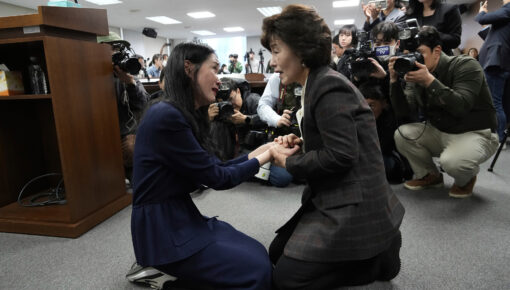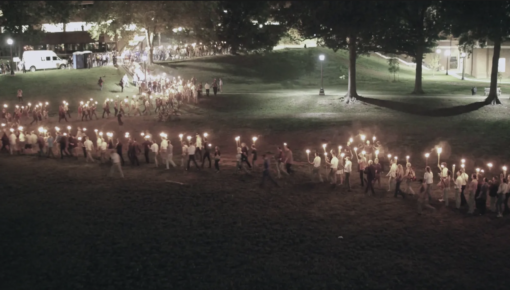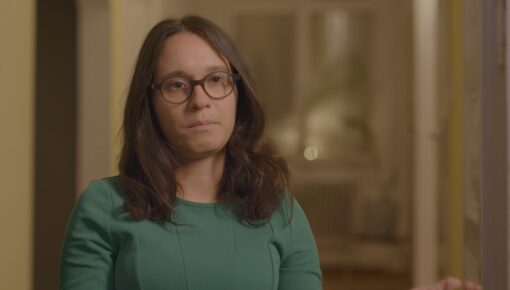10 Things You May Not Know About Waco

Fire engulfs the Branch Davidian compound near Waco, Texas, April 19, 1993. (AP Photo/Ron Heflin) (AP Photo/Ron Heflin)
It’s been 25 years to the day since the standoff began between the federal government and the Branch Davidians in Waco, Texas.
What began as the longest shoot-out in American law-enforcement history turned into a weeks-long siege that ended 51 days later with 75 people dead, many of them women and children. It also left a lot of questions.
In 1995, FRONTLINE obtained access to the Waco files — 7,000 government photographs, wiretaps and hundreds of hours of telephone negotiation tapes that had never been publicly revealed. The collection, along with interviews by FRONTLINE with some of the main actors involved, offered new insight into the Davidians, their compound standoff, and its fiery conclusion.
Here are the most surprising revelations from FRONTLINE’s Waco: The Inside Story:
Nobody knows who shot first.
Gunfire broke out on the compound when ATF agents arrived with arrest and search warrants against David Koresh and the Branch Davidian compound, based on evidence that the Davidians were illegally stockpiling weapons. How did the shootout begin? It still isn’t clear. But amid the gunfire, Koresh called 911 to report the shooting — and to preach.
A partial transcript of the call:
911 OPERATOR: 911.
DAVID KORESH: Hello?
911 OPERATOR: Yes?
DAVID KORESH: This is Dave Koresh.
911 OPERATOR: This is who, sir?
DAVID KORESH: David Koresh, Mount Carmel Center. We’re being shot all up out here.
911 OPERATOR: Okay. Where are you?
DAVID KORESH: Where am I? I’m at Mount Carmel Center!
911 OPERATOR: Okay, hang on just a second.
DAVID KORESH: All right.
DEPUTY SHERIFF: Yeah, this is Lynch [sp?].
DAVID KORESH: Hey, Lynch?
DEPUTY SHERIFF: Yeah?
DAVID KORESH: This is David Koresh —
DEPUTY SHERIFF: Okay, David.
DAVID KORESH: — the notorious. Why’d you go and do that for? You brought a bunch of guys out here and —
Then Koresh, in the midst of the gunfire, began to preach from the Bible.
DAVID KORESH: There are seven seals.
DEPUTY SHERIFF: All right.
David Koresh wasn’t his real name.
It’s actually Vernon Wayne Howell. Born in 1959, Koresh grew up in Houston, Texas, the son of a single mother. Koresh told the FBI in their late-night chats during the standoff that he was a lonely child, teased by other kids who called him “Vernie.” He struggled in school, but was drawn to the Bible, large portions of which he memorized despite being dyslexic.
Koresh joined the Branch Davidians at age 22, and became involved with the sect’s prophetess, Lois Roden. After she died, Koresh challenged Lois’ son George for control, showing up with seven heavily armed followers at the Waco compound. Roden ended up shot in the head and chest, and Koresh and his men were charged with attempted murder. The seven were acquitted; a mistrial was declared for Koresh, who told the jury they’d aimed at a tree.
Then, he assumed leadership of the Branch Davidians. That’s when he changed his name to David Koresh — “for publicity and business purposes,” according to court documents.
What did his new last name mean? He told one FBI agent at first that it meant death, and then that it was a surname from God.
Koresh told his followers he was the Messiah — but he may not have believed it himself.
FBI agents told FRONTLINE that any Branch Davidians who wanted to leave the compound had to undergo an “exit interview” with Koresh, who would remind the wayward follower that to abandon him was to reject salvation.
But he may not have actually believed this himself, according to one negotiator who engaged Koresh in conversation during the standoff. In transcripts of his conversation with Byron Sage, an FBI negotiator, Koresh danced around the question:
SAGE: And so you are now claiming clearly and simply that you are the Christ.
KORESH: I am saying that no man can know me nor my father unless they open their book and give a fair chance in honesty and equity to see the seals.
After that conversation, Sage told FRONTLINE he was convinced Koresh was lying. “I tell him that I am absolutely confident in my salvation and he’s not in a position to challenge it,” he said. “Now, if anyone was in a position to try to challenge my faith as a Christian, it would be someone that perceives himself to be Christ. He does not assume that posture. From that point forward, it is absolutely patently clear in my mind what we’re dealing with. This guy is not delusional. He is not a Messianic complex. He does not buy off on his own con.”
The Davidians thought the Devil rules the world.
The Davidians were well-educated. Koresh’s deputy had a theology degree, and another was an attorney. So what did they believe?
The Davidians believed that the Bible is the literal word of God, and that the prophecies in the book will be fulfilled, said Clive Doyle, a Branch Davidian who spoke to FRONTLINE in 1995 about life on the compound before the raid and the group’s beliefs. One of the more important: the Bible’s Book of Revelation, which they believed details the end of the world. The Davidians believed that at that time, God would judge everyone, punishing the sinners and rewarding the good in a special kingdom.
“We don’t perhaps use the same terminology or get into all the conspiracy theories that some people that promote that idea promote,” Doyle said.
“But on the other hand, we do believe that the Devil is in control of the nations of the world, and that they are merging toward what the Bible calls Babylon the Great.”
The FBI slipped listening bugs into milk cartons they sent into the compound.
Koresh had previously allowed a few children to leave the compound. So the FBI offered to deliver milk to the compound if more were released. Koresh refused the deal. But the FBI sent in milk anyway, and got something else from the delivery: They planted listening bugs in the milk cartons and their styrofoam containers.
“It was very chancy,” recalled Jeff Jamar, the FBI’s on-site commander for Waco. “You would send them in and you didn’t know where it would end up.”
One of the bugs found its way into a room with Koresh. Some of the talk was mundane:
DAVID KORESH: [surveillance tape] Rachel!
RACHEL: What?
DAVID KORESH: Keep those children under control. They won’t be singing that today.
Other talk was more troubling:
DAVID KORESH: [surveillance tape] Let me send some guys up there and blow their heads off.
The bugs also allowed the agents to get a read on their reaction to an initial face-to-face meeting between Koresh’s deputy, Steve Schneider, and FBI negotiator Byron Sage.
STEVE SCHNEIDER: [surveillance tape] Byron, I liked — man, what a person. I liked his personality. I believe he was 100 percent sincere. I saw his concern in his face and eyes. I really —you know, I believe what he’s trying to do —
The breakthrough didn’t last long. Koresh didn’t permit any more in-person meetings.
Two FBI teams clashed over how to handle Koresh, and it spilled over into name-calling.
The FBI had two teams working to end the standoff: The negotiators, who tried to establish a relationship with Koresh and the other Davidians, and the Hostage Rescue Team, which handled the tactical maneuvers. The two sides were often at odds.
Negotiators felt hamstrung by a hostage rescue team that made aggressive moves — blaring music, crushing Davidians’ cars and a guard shack — in the midst of delicate discussions with Koresh.
The hostage teams, meanwhile, felt the negotiators should have pressured the Davidians by denying them food or water, or cutting the power, according to Barry Higginbotham, a member of the FBI hostage rescue team at Waco, who spoke to FRONTLINE in 1995.
That led to a lot of tension. Here’s one example:
BYRON SAGE, FBI negotiator and supervisory senior resident agent: On occasions, I made a number of trips up to the tactical sites located right out in front of the compound. There was one time when there was a notation on one of the portable outhouses up front that said, “Sage is a Davidian,” obviously written by one of the tactical guys.
FRONTLINE asked a member of the hostage rescue team, James McGee, about it. He chuckled:
That would be very symbolic of the frustration. There was a high level of frustration.
Koresh repeatedly told investigators he wasn’t planning a mass suicide. Many in the FBI believed him.
Convinced that Koresh might eventually surrender, the negotiators kept talking to Koresh, offering him opportunities to broadcast his message on the radio and television.
The FBI finally determined to tear gas the compound only when they learned that the Davidians had supplies to hunker down for as long as a year.
“If we knew it was going to be suicide, we wouldn’t have done it,” said Jeff Jamar, the FBI’s on-site commander at Waco, of the tear gas plan, in a 1995 FRONTLINE interview. “We’d have put — like everybody said, make it a federal prison. … But he still would have had that end. I’m convinced, by what he did on the 19th, that he had to have that end.”
The FBI told Attorney General Janet Reno that children were being abused at Waco, even though it wasn’t true.
Reno initially rejected the FBI’s tear gas plan as being too aggressive. A strong advocate for children, Reno was concerned the Davidians might use the children as human shields if the FBI launched an offensive. Then Reno said she heard from the FBI that the children at Waco being abused. She told ABC News’ Nightline:
We had had reports that they had been sexually abused, that babies had actually been beaten. I asked when I first heard that for them to verify it and, again, that was the report that was brought back.
It wasn’t true, and the FBI knew it. So who told her? William Sessions, the FBI director at the time, told FRONTLINE he wasn’t the one. But someone at the FBI did, according to documents FRONTLINE uncovered. It’s just not clear who.
Ultimately, Reno approved the gas plan. Agents began spraying tear gas into the compound the morning of April 19, 1993.
The Davidians started the lethal fires that day.
About six hours after the tear gassing began, flames simultaneously erupted at three separate locations on the compound. Audio recorded by the milk-carton bugs suggests the Davidians started the fires, acting on orders from Koresh.
1st DAVIDIAN: [surveillance tape] Start the fire?
2nd DAVIDIAN: Got some fuel around here?
3rd DAVIDIAN: Right here.
PETER BOYER: The audio bug tapes from the morning of the fire were the critical evidence.
4th DAVIDIAN: [surveillance tape] Did you pour it yet?
5th DAVIDIAN: Huh?
4th DAVIDIAN: Did you pour it yet?
5th DAVIDIAN: I haven’t yet.
6th DAVIDIAN: David said pour it, right?
5th DAVIDIAN: Did he? Do you want it poured?
6th DAVIDIAN: Come on. Let’s pour it.
5th DAVIDIAN: Do you want it poured already?
7th DAVIDIAN: We want some fuel.
5th DAVIDIAN: I’ve got some here.
8th DAVIDIAN: We should have gotten some more hay in here.
9th DAVIDIAN: I know.
Most of the Davidians died of smoke inhalation after the fire began.
The compound didn’t cool down until a week later. Investigators found 75 bodies. Only nine of the Davidians had escaped the fire. All of the remaining 25 children perished.
Koresh and his deputy, Steve Schneider, were found with fatal wounds to their heads, suggesting suicide, or murder-suicide, according to Dr. Nizam Peerwani, the chief medical examiner for Tarrant County in Northcentral Texas who spoke to FRONTLINE in 1995.
Peerwani said that 50 people had died of smoke inhalation. Most of the women and children were found in a concrete bunker full of guns and ammunition.
“There has been a lot of speculation if this is a mass suicide or not. Did they all go there to die? We don’t really think so,” Peerwani said. “What I feel personally is that they tried to escape. A bunker was perhaps the safest area in the compound.”
For more, check out FRONTLINE’s 1995 website for Waco: The Inside Story, which contains transcripts of the FBI negotiations, interview excerpts, photos and a full chronology of the Waco siege.
Editor’s Note: This story was updated on Feb. 28, 2018 to mark the 25th anniversary of Waco. It was originally published on the 20th anniversary of the standoff in 2013.





